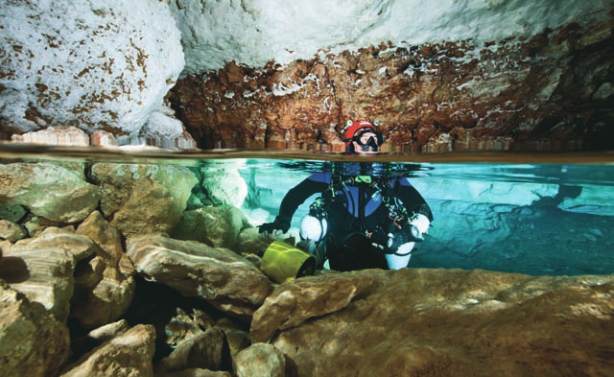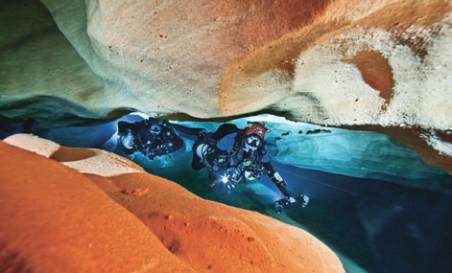Basic HTML Version



www.alertdiver.com
|
39
Some caves actually look like the surface of the moon,
with pale white limestone carved into strange, unearthly
shapes. In other caves the water moves along rapidly,
and divers swim against the flow going into the cave
and, if the passages are large enough, fly along with the
flow heading out. Dives like these are truly remarkable
experiences. On the other side of the coin, sometimes the
water flows inward from the entrance, and divers need to
be extra cautious to turn around with enough remaining
gas to swim against the flow and still make it out with gas
in reserve for safety.
To the trained eye, caves offer as much variety as exists
between different shipwrecks or different reefs. Some caves
have white walls, some dark walls that eat your torchlight,
and some have stripes from alternating seasons that either
send dark water into the cave or clean water to flush it out.
Because they are most commonly made of limestone, many
caves have beautiful fossils embedded in the walls.
Strange animals live in caves. Having adapted to the cave
environment over eons, they may lack pigmentation and
appear pale white; many are blind with extra-long feelers to
detect food in the complete dark.
In the same way ocean divers often
develop a store of knowledge over time,
so too do cave divers, and conversations
leading up to and following dives are as
animated as those on any dive boat. In
short, cave diving offers an opportunity to
visit unique environments with adventure
aplenty and as part of a dive group that
shares a passion.
How to Start Cave Diving
The path from recreational diver to cave
diver is now clearly marked. First, we
start in caverns and learn the basics of
safe cave diving. These include the five
golden rules, which cover gas planning,
maximum depth, adequate lighting,
marking the trail and the need for training. New skills
introduced at this time include finning techniques such as the
frog kick. This kick can minimize the risk of stirring up silt,
which could disorient divers and cause them to lose their way.
After the cavern diver course, we usually go dive caverns
as much as we can until we start shining our torches
around the bend and thinking, “I wonder what’s down
that passage.” The next level of training is usually an
intermediate phase in which divers start diving with more
than one cylinder and practice running line. Several types
of reels are available today, and divers should learn to use
the ones they will be using after the course. Some caves
have a “gold line” from the entrance through the main
passage; some require the lead diver to lay line beginning
some distance beyond the entrance to prevent curious
novices from following the gold line into the cave. This
training level usually comes with some restrictions so
we don’t go too fast too soon: “no leaving the main line
to explore side passages” or a gas restriction such as “no
diving beyond a third of a pair of doubles,” for example.
Different training agencies have different restrictions, but
they are all intended to encourage new cave divers to gain
experience before moving even farther into the earth.

